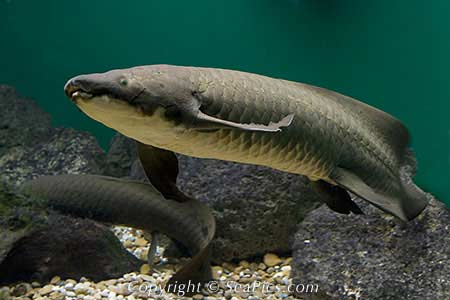
Lungfish fossils first appear at the beginning of
the Devonian period, about 400 million years
ago. Once distributed around the world, lungfish
now occur in only three areas (South America, Africa,
and Australia) that were once adjacent but
have since separated due to continental drift.
South American and African lungfish are more
closely related to one another. They have reduced
gills and two lungs and are true air breathers,
while Australian lungfish have one lung and rely
mostly upon their gills for respiration, gulping air
at the water surface to breathe only when dissolved
oxygen is in short supply.
African and South American Lungfish
There are two related families in this order. The
African family, Protopteridae, has one genus
(Protopterus) and four species (P. annectens, P.
aethiopicus, P. dolloi, and P. amphibius). They live in
the rivers, lakes, and swamps of East and Central
Africa and grow to 2 meters (6.5 feet) in length.
The South American family, Lepidosirenidae, has
only one species, Lepidosiren paradoxa. It lives in
swampy areas of the Amazon and ParanГЎ river
basins and in the swamps of the Chaco region and
grows to 1.2 meters (4 feet) in length.
During spawning season, males dig holes for
the eggs and guard both eggs and young after
they hatch. The South American male develops
branched, gill-like structures on his pelvic fins
that may supply extra oxygen to himself as he incubates
and to his offspring. Juveniles hatch with
adhering organs to attach to plants. They have external
gills like salamander young and undergo
metamorphosis. Adults live on crustaceans, mollusks,
and small fishes. They survive the dry season
by resting quietly in moist burrows dug in the
mud. If it becomes too arid, they seal their burrows
with mud, secrete a protective covering of
mucus, and estivate, sometimes for several
months. During estivation, metabolism slows
down to conserve energy and air. Once the rainy
season begins, water enters the burrowand awakens
the estivating fish.
Australian Lungfish
The Australian lungfish was first
discovered in 1870. This lungfish
closely resembles fossil lungfishes
except that its skull contains fewer,
larger bones. It has remained unchanged
for 100 million years or
more, longer than any other vertebrate
known. There is now only
one living species of this order,
Neoceratodus forsteri, and it occurs
naturally in only two locations, the
Burnett and Mary rivers in Queensland,
Australia, although it is being
introduced into other rivers in an
effort to ensure its survival. During
the summer, the rivers dry up, and
the lungfish survive in small pools.
They cannot estivate.
Spawning takes place after the
rainy season starts. The eggs are
laid in masses of fifty to one hundred
on aquatic plants. The young
breathe through the gills and skin.
They do not have adhering organs
or external gills and do not undergo
metamorphosis. They develop pectoral
fins at about fourteen days
and pelvic fins at about ten weeks, gradually assuming
the adult shape. They feed on algae, but
adults feed on small fishes, mollusks, crustaceans,
insect larvae, and some plants and grow to a size
of about 1.8 meters (6 feet) and forty-five kilograms
(one hundred pounds). They have broad,
flat heads with the mouth underneath, small eyes,
and pointed tails. The body is olive green or
brown above and pinkish below.
Lungfish Facts
Classification:
Kingdom: Animalia
Subkingdom: Bilateria
Phylum: Chordata
Subphylum: Vertebrata
Superclass: Gnathostomata
Class: Osteichthyes
Subclass: Sarcopterygii
Order: Dipnomorpha or Dipnoi
Families: Lepidosirenidae (African and South American lungfish);
Dipnorhynchidae, Dipteridae, Phaneropleuridae, Ctenodontidae,
Conchopomidae, Sagenodontidae, Ceratodiae (Australian
lungfish)
Geographical location: Africa, Australia, and South America
Habitat: Freshwater only (rivers, lakes, swamps, and marshes)
Gestational period: Australian lungfish, twenty-one to thirty
days; African and South American lungfish, eleven to fifteen
days
Life span: Unknown; larger fish may live to be many years old
Special anatomy: Elongated bodies, continuous rear fins composed
of connected dorsal, caudal, and anal fins; Australian
lungfish-laterally compressed body, large scales, two pairs of
flipperlike pectoral and pelvic fins, one lung; African and
South American lungfish-eel-like body with small scales,
two pairs of long, thin pectoral and pelvic fins, paired lungs
Other popular Animals
Photo Gallery of - Lungfish
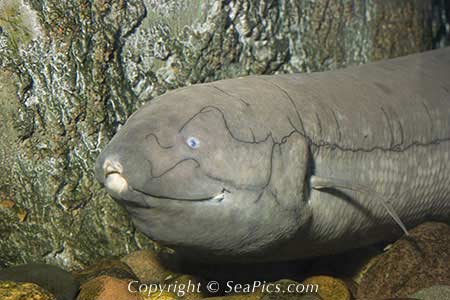
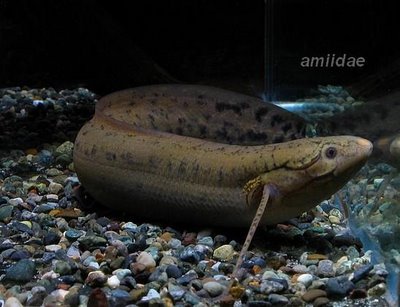
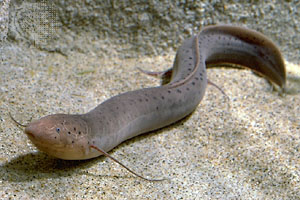
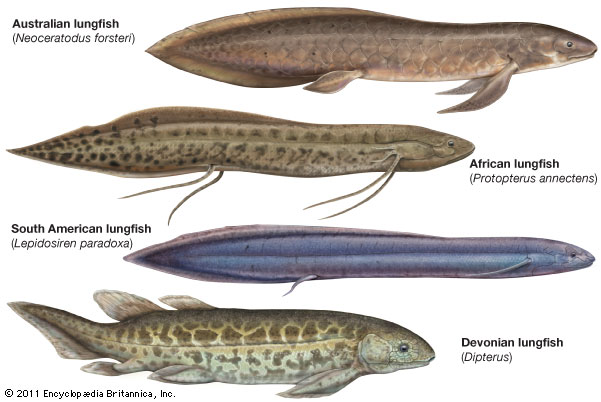
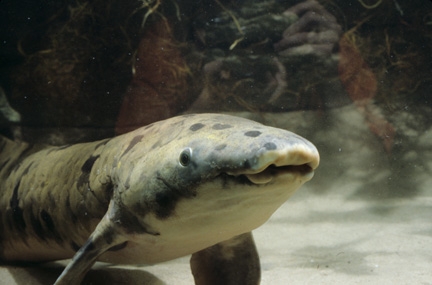
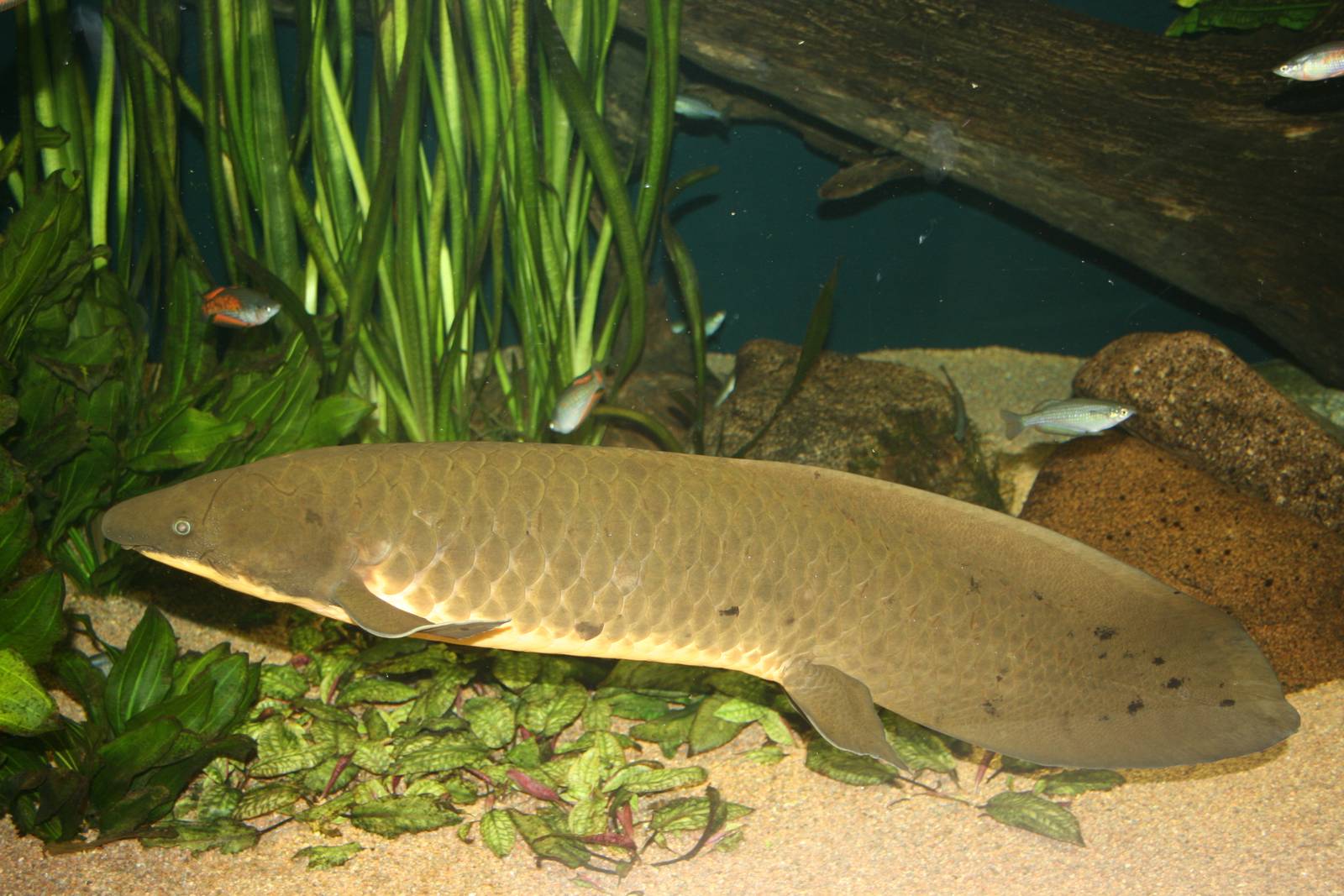


 Animalia Life
Animalia Life